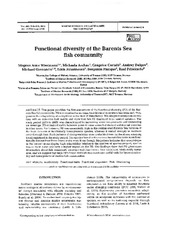| dc.contributor.advisor | Aschan, Michaela | |
| dc.contributor.author | Wiedmann, Magnus Aune | |
| dc.date.accessioned | 2014-06-16T10:58:09Z | |
| dc.date.available | 2014-06-16T10:58:09Z | |
| dc.date.issued | 2014-06-06 | |
| dc.description.abstract | SUMMARY
This is a study of the fish community in the Barents Sea and its vulnerability to
disturbance such as fishing and climate change. The vulnerability of the fish community
depends on its sensitivity to, and adaptability under, stress. To assess these two components
of vulnerability, I have combined survey data from the Barents Sea with information about
the species properties (i.e., traits), following three approaches. 1) To study the adaptability
under disturbance, I have focused on functional diversity, which is a measure of the
interspecies functional dissimilarities. 2) To study the sensitivity of the fish community
functioning to the loss of species, I have assessed functional redundancy. 3) I have assessed
the sensitivity of single species to fishing. For all these three measures, I have mapped the
spatial variation throughout the Barents Sea. I have chosen to focus on the time period 2004-
2009, a period that was characterized by heating water masses and declining sea ice coverage
in the Barents Sea.
The analyses indicate that the fish community has a relatively low vulnerability in the
central and south-western parts of the Barents Sea. However, many of the species found there
are also fishery-sensitive. Further to the north and east, the community vulnerability appears
to be higher due to lower functional diversity and redundancy. The analyses also show that
fish that traditionally are found further south moved northwards. This is interpreted as a sign
of borealization, which likely occurred due to a heating of the water masses. This pattern is
particularly eminent in the northern and north-eastern parts of the Barents Sea, where
commercially attractive species establish that are also sensitive to fishing. Since the
ecosystem in these northern areas can be vulnerable, and since it is very little studied,
cautiousness is required. Future studies that focus on the species’ life histories and functional
roles will enhance our understanding of the ecosystem vulnerability. | en |
| dc.description.doctoraltype | ph.d. | en |
| dc.description.popularabstract | SAMMENDRAG
Dette er et studium av fiskesamfunnet i Barentshavet og dets sårbarhet til
stressfaktorer som fiskeri og klimaendringer. Fiskesamfunnets sårbarhet bestemmes av dets
sensitivitet til og tilpasningsdyktighet under stress. For å belyse disse to komponentene av
sårbarhet har jeg integrert toktdata fra Barentshavet med informasjon om fiskenes
egenskaper. Jeg har fokusert på tre innfallsvinkler. 1) For å studere tilpasningsdyktighet
under stress har jeg valgt å fokusere på et konsept som heter funksjonell diversitet, som er et
mål på hvor ulike fiskene i et fiskesamfunn er funksjonelt. 2) For å studere hvor sensitivt
fiskesamfunnets funksjon er til tap av arter har jeg studert et konsept som heter funksjonell
redundans. 3) Jeg har også vurdert hvor sensitive enkeltartene er til fiskeri-indusert stress. For
alle tre innfallsvinklene har jeg kartlagt romlig variasjon i Barentshavet. Jeg har valgt å
fokusere på tidsperioden 2004-2009, en periode som karakteriseres av økende
vannmassetemperatur såvel som minkende isutbredelse i Barentshavet.
Undersøkelsene tyder på at fiskesamfunnet som helhet har relativt lav sårbarhet i den
sentrale og sørvestre delen av Barentshavet, men at mange av artene her også er sensitive til
fiskeri. Lenger nord og øst i Barentshavet ser sårbarheten til fiskesamfunnet ut til å være
høyere, på grunn av lavere funksjonell diversitet og redundans. Undersøkelsene viser også at
arter som tradisjonelt hører til lenger sør, flytter nordover. Dette tolkes som en borealisering
av fiskesamfunnet, og skjer trolig som følge av den pågående oppvarmingen av vannmassene.
Dette mønsteret er spesielt tydelig for de nordlige og nordøstre delene av Barentshavet, der
arter som er kommersielt attraktive, men også sensitive til fiskeri, nå begynner å etablere seg.
Siden økosystemet i disse nordlige områdene kan være sårbart, og siden vi har lite kunnskap
om det, bør det utvises forsiktighet her. Fremtidige studier som fokuserer på artenes
livshistorier og funksjonelle roller vil kunne styrke kunnskapen om økosystemets sårbarhet. | en |
| dc.description.sponsorship | Norwegian Research Council | en |
| dc.description | Papers 2 and 3 of this thesis are not available in Munin: <br/>2. Wiedmann MA, Aschan M, Greenacre M, Dolgov A, Primicerio R.: 'Functional redundancy in Barents Sea fish: ecological implications of environmental change' (manuscript). <br/>3. Wiedmann MA, Primicerio R, Dolgov A, Ottesen CAM, Aschan M.: 'Life history variation in Barents Sea fish: implications for sensitivity to fishing in a changing environment' (manuscript). | en |
| dc.identifier.isbn | 978-82-8266-081-5 | |
| dc.identifier.uri | https://hdl.handle.net/10037/6384 | |
| dc.identifier.urn | URN:NBN:no-uit_munin_5965 | |
| dc.language.iso | eng | en |
| dc.publisher | UiT The Arctic University of Norway | en |
| dc.publisher | UiT Norges arktiske universitet | en |
| dc.rights.accessRights | openAccess | |
| dc.rights.holder | Copyright 2014 The Author(s) | |
| dc.rights.uri | https://creativecommons.org/licenses/by-nc-sa/3.0 | en_US |
| dc.rights | Attribution-NonCommercial-ShareAlike 3.0 Unported (CC BY-NC-SA 3.0) | en_US |
| dc.subject | VDP::Mathematics and natural science: 400::Zoology and botany: 480::Ecology: 488 | en |
| dc.title | A trait-based assessment of the Barents Sea
fish community: implications for vulnerability
under environmental change | en |
| dc.type | Doctoral thesis | en |
| dc.type | Doktorgradsavhandling | en |


 English
English norsk
norsk

